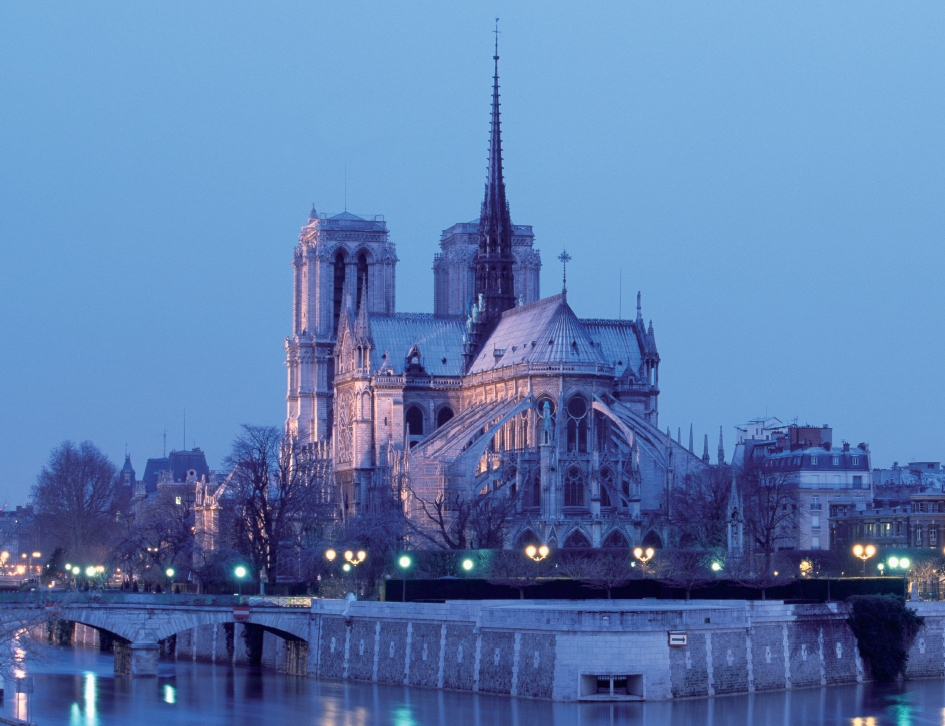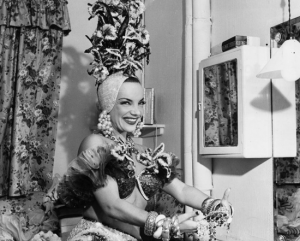Winner of the Fall 2016 StMU History Media Award for
Best Featured Image
Whenever we hear the name Notre Dame, one of two things might come to mind: the movie that we all watched and loved, about a man who rang the bells at a church, called “The Hunchback of Notre Dame,” or the notorious Fighting Irish football team in Indiana from Notre Dame University. Well, if you were hoping that this was an article on Quasimodo or the Division I football team, I am sorry to disappoint you. But do not be too discouraged because, instead, you will read about one of the most beautiful cathedrals that has ever been built (and it is in the film the “Hunchback of Notre Dame,” so that is relatively close). The Notre Dame de Paris, or as we call it in English, the Notre Dame Cathedral, is a massive Gothic cathedral that represents the times and art of medieval Europe.
The architectural style of Gothic came into existence in Europe in the mid-twelfth century and lasted until the sixteenth century.1 The idea of the Notre Dame de Paris, which translates to “Our Lady of Paris,” was established by Maurice de Sully in 1160 who was the bishop of Paris at the time.

He wanted to build a cathedral church dedicated to the Virgin Mary; hence the name’s translation. The first stone for the foundation was laid by Pope Alexander III in 1163.2 The Notre Dame Cathedral was built on the ruins of two previous churches in the eastern end of the Ile de la Cite, which is the “historical heart of the city.”3 The purpose for it being built, beside dedication to the Virgin Mary, was for it to be an education center. During the high middle ages, the increasing wealth and social complexity of the cities created the demand for educated individuals to deal with “political, legal, and theological issues.” The institution did not, however, hold classes inside of the cathedral. Instead, there was a school connected to the cathedral.4

Emerging from the Romanesque Era, the Gothic Age of architecture came along with its signature innovation: the flying buttress. You probably think I am joking with a name like that, but those types of appendages to the frames of Gothic cathedrals were what allowed for these cathedrals to be built so tall. During the Romanesque Era, cathedrals were much shorter due to the heavy stones that were used for building the walls, limiting how tall they could build. The classic Roman arches could not evenly distribute the weight with the dome shape they took.5
Now if we take a look at the cathedrals during the Gothic Age, the difference in height can be readily noticed. The cathedrals during this time seemed to tower over those of the previous era. For that, we can thank the flying buttresses that were mentioned earlier. These buttresses were able to absorb the weight displacement of the walls, allowing them to be made taller, and allowing them to have large spaces for stained glass windows, which were not possible for Romanesque cathedrals. The weight of the stones could be easily supported by the thin intersecting arches. The architects discovered that the outward thrust of the vaults were concentrated in the small areas at the springing of the ribs and were also deflected downward by the pointed arches; the pressure could be counteracted by the narrow buttresses. Rows of carved flying buttresses created the signature look for Gothic masterpieces such as the Notre Dame de Paris, Amiens, and Beauvais.6
The Notre Dame de Paris is a model cathedral for the era of Gothic Architecture. The multipurpose cathedral created an environment of religious and secular education that helped shape the minds of the world. I know that there was no mention of a “Hunchback” in this article of the Notre-Dame, but I can guarantee that Quasimodo was proud to ring the bells of such a monumental cathedral.
- Encyclopaedia Britannica, s.v. “Gothic Architecture.” ↵
- Columbia Electronic Encyclopedia, 6th Edition s.v. “Notre-Dame de Paris.” ↵
- Encyclopaedia Britannica, s.v. “Notre-Dame de Paris.“ ↵
- Earle E. Cairns, Christianity Through the Centuries: A History of the Christian Church (Zondervan, 1996), 234. ↵
- Funk & Wagnalls New World Encyclopedia, 2016, s.v. “Romanesque Art and Architecture.” ↵
- Funk & Wagnalls New World Encyclopedia, 2016, s.v. “Romanesque Art and Architecture.” ↵



125 comments
Daniel Gimena
Nice article about art and architecture.
It is always good to find articles that talk about art history as that, unfortunately, is not a common topic nowadays.
The article describes perfectly the beauty and visual power that the cathedral transmits. Anyone who has visited Paris and took the time to visit this worldwide known construction can ratify this.
The main takeaway from the lecture is the explanation of the buttresses. Personally, I had heard about them, but had never been taught about what they real use was. It amazes me to think about how people at that time built buildings like the “Notre Damme de Paris”, using technics like the buttresses.
I also liked the author’s use of Irony when mentioning the famous “Hunchback” and the Fighting Irish football team, which I think that catches readers’ attention and makes them willing to finish the article.
Sara Davila
It is so heartbreaking that such a beautiful and important Cathedral burned. I loved learning about the Notre Dame de Paris and its intricate and detailed architecture. I have always taken interest in the gothic age of architecture because the buildings are so unique. I didn’t know it was built dedicated to the Virgin which makes it even more of a beautiful.
George Assaf Lozano
I’ve always admired the beautiful architecture that the Notre Dame Cathedral displays, yet I never knew about the innovation it contained. Gothic architecture is amazing and personally one of my favorites because of how intricate it could be. I enjoyed how you made references to the Hunchback of Notre Dame, it was interesting to find out that the flying buttresses made it possible to build taller structures.
George Assaf
I’ve always admired the beautiful architecture that the Notre Dame Cathedral displays, yet I never knew about the innovation it contained. Gothic architecture is amazing and personally one of my favorites because of how intricate it could be. I enjoyed how you made references to the Hunchback of Notre Dame, it was interesting to find out that the flying buttresses made it possible to build taller structures.
Sara Alvirde
When I heard that the Notre Dame Cathedral burned down I was so devasted but never really knew the full history of the Cathedral. It was nice to learn facts about the building like how it was dedicated to Virgin Mary and how it was an education center. Such a wonderful and valuable piece of history that I hope that it can be build again and stay protected.
Alyssa Ramos
It is upsetting that such a beautiful and meaningful Cathedral burned. I loved learning about the Notre Dame de Paris and its architecture. I love the gothic age of architecture because the buildings are so unique and wonderful. The Notre Dame de Paris is such a beautiful place and I wish I can see what remains one day. I didn’t know it was built dedicated to the Virgin Mary, but that makes it even more of a masterpiece. Also, I have never seen The Hunchback of Notre Dame.
Adrianna Hernandez
When I first read the article title I imagined it was going to be about a woman, but it wasn’t it was actually about the Notre Dame Cathedral. I didn’t know it was built in dedication to the Virgin Mary. I like how it mentions the meaning of Notre Dame De Paris. I’m amazed at how it was influenced by Gothic architecture.
Nadia Manitzas
I never had the luxury of seeing this beautiful piece of art simply due to the fact that I’ve never traveled to France and the cathedral burned down a couple of months ago. This article describes the structure of the cathedral and the Gothic architecture that influenced the design of The Norte Dame. It’s also kind of funny how an innovation is called the buttress, that made me giggle but it was a highly important part to the structure. Overall, the article was very interesting and well written. I would recommend this to anyone who is interested the Notre Dame.
Margaret Maguire
The Notre Dame Cathedral is beautiful. someday I would like to go see it. This article was really interesting. I really like how the flying buttresses were explained. I never really understood how they worked, I knew that they were structural support but how did the arches do that. The flying buttresses were better at evenly distributing weight across itself then the traditional Romanesque arches. I enjoyed reading and learning about the Notre Dame Cathedral.
Jacob Silva
In my art history class a few years ago we studied a few churches and the architectural design behind them is, either being Gothic, Romanesque, or Antiquity. Based on my study on these forms I’ve always attributed the style of Gothic to Notre Dame as this was a famous church we didn’t study and I was right, according to the article it is Gothic. The chosen pictures also support and display that this is Gothic.